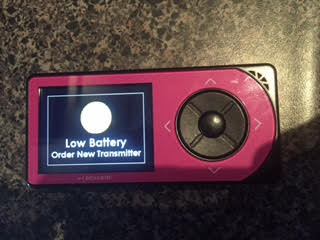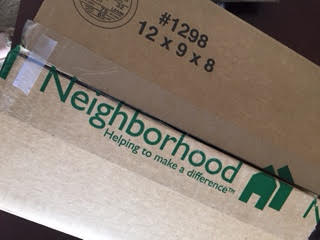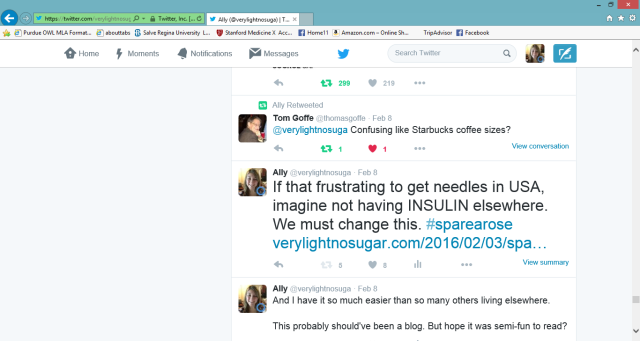If I were to fit the stereotype of a self-absorbed Millennial, I shouldn’t give an albino squirrel’s @$$ that UnitedHealthcare will solely cover Medtronic insulin pumps in the near future.

^ Albino squirrel spotted in Washington, DC. He told me that a laboratory cured him of diabetes!
Well, albino squirrels are real, and so is this Millennial.
I do care.
My insurance provider is not UnitedHealthcare. I walked away from my Medtronic insulin pump over a year ago. Currently, I manage my type 1 diabetes using Lantus and Humalog insulin pens, the traditionalist method of being certain that insulin is getting into my body. My stomach bears the bruises to prove it.
Disappointment still lingers when I think about the divorce from my Medtronic insulin pump. I identified an infusion set defect, and spiked high ketones with every site change. I pleaded with Medtronic to help, to find an alternative solution, to listen and to trust me. For awhile, they did. But then the problems kept happening, and I kept emailing, and they finally chose to stop responding.
They walked away. If only I could abandon my type 1 diabetes so easily…
I have been vocal about my insulin pump tribulations, but I have always given Medtronic the benefit of the doubt at the end of the day. My situation was a rarity; most people have good hearts; the manager who did not respond to my emails was told to do so by higher-ups who feared a lawsuit; she went home at night and felt a twinge of guilt, wondering if I was still sick with ketones from my failed pump sites.
At least that’s how I try to imagine it.
When I first saw the headlines about UHC and MDT teaming up, I was frustrated but not surprised. Finally, people were seeing the light. Rather, the darkness.
Our healthcare system involves give and take, tug-of-war with patients’ quality of life and companies’ profits at stake. Although the Affordable Care Act gave us coverage for pre-existing conditions, the ability to stay on our parents’ plans until age 26, and supposedly lower costs, the reality is that in order to receive, we also have to give. To cut costs in one place, costs have to shift somewhere else.
Medtronic and UnitedHealthcare are not the only companies out there striving to make a profit in a newly-designed medical playing field. Perhaps their business arrangement was intelligent for their own financial reasons. Public relations-wise, not so much. Only time will tell the true breadth of this so-called deal.
As we over-emphasize cost-cutting, we must be careful not to also snip choice and patient autonomy. Reducing costs sounds great in the short-term, but we cannot disregard the long-term. If patients’ health is compromised by inadequate access to resources, all the costs that insurance companies may have saved upfront will later be seen in hospital bills and subsequent treatment.
Under my current insurance plan, a preferred provider organization (PPO), I can go out-of-network if I so choose and if I have the capability to pay more for that care. There are times where I believe wholeheartedly that an out-of-network provider is the absolute best shot at achieving better health. That is my prerogative, and, understandably, my financial situation to figure out. While the pricing may not be pleasant, what is most important to me is that I am able to access that care. If high-quality care means sacrificing my own money for a vacation or a fancy new car, that is my choice. If my financial situation changes later on, perhaps I will have to reassess and fall back to an in-network provider. Yet such ability to choose should never be limited by the government or by insurance providers.
Collusion of insulin pump coverage is concerning not only for the diabetes community, but for healthcare at large. Imagine the ramifications of collusion in multiple disease categories, of various insurers, corporations, and pharmaceutical companies. Sure, big business is big business, but ethics should be ethics, too.
Notably, in “socialized healthcare” situations all over the globe, we must concede how much give-and-take is occurring. Patients may have to wait months to be seen by a provider, and that provider may be mediocre. Such is the sacrifice for limiting the free market. On the flip side, we have gargantuan healthcare costs here in the U.S. because we roll the dice on access and affordability of treatment in the name of corporate greed. If the grass is apparently always greener, well, it looks pretty yellow from my point of view, no matter how or where you slice healthcare financing.
Next weekend I will walk at my Commencement ceremony, having completed my Master of Science in Healthcare Administration and Management degree in December of 2015. The UHC/MDT situation reminds me of a moment in our Public Health course. As our Professor detailed how “money talks” in medicine, a longtime nurse in the class shook her head, visibly horrified.
“Is that really how this all works? People don’t simply want to help others who are hurting?” she asked, bewildered.
She was like the little kid learning that Santa is not real, her innocence suddenly dissipating before our eyes.
The reality of healthcare is that money does talk. Yet, like my classmate, we have to keep the hope alive in our hearts that some of us good eggs are in it for the long haul, for improving lives and fostering genuine human connection in the process. Medtronic and UHC have called such goodhearted concepts into question, which is why we are now experiencing #AllOfTheFeelings.
Circling back to my personal, weird insulin pump scenario: The things that kept me afloat during such dire straits were my compassionate healthcare team, and the ability to choose. When my Medtronic pump was no longer a good fit for me, some semblance of hope remained. I could always sidestep over to a different insulin pump brand, for example. Or, I could return to multiple daily injections, which I ultimately decided to do. My doctors and nurses listened to me; they trusted my judgment as an informed, engaged patient; and they lifted me up on the days when it all seemed too heavy a cross to carry on my own.
Not one second of that ordeal was easy. But we did it, somehow.
My advice to those overwhelmed by anxiety about access to health technology in light of the UHC/MDT deal is that you will survive somehow, too. It may not be enjoyable. It royally sucks that such a violation of your trust as a consumer has occurred, and that your freedom of choice has been stripped away. It is morally reprehensible that this is happening under the guise of expanding innovation; limitation of choice, in fact, stifles creativity at all levels. You have a right to be angry as hell. Lean on each other liberally. Remember that there are people overseas, or even in our own backyards, who do not have access to insulin. Our voices must lift them up, too.
Hard times boil down to the good eggs and the bad, the people who answer emails filled with desperation and suffering, the companies which accept responsibility and troubleshoot the issues, the patients who never stop advocating no matter how sick they feel, and the medical teams which have their backs.
Healthcare is a complicated equation. But we are on the right side.
We are the people who care.
Medtronic and UnitedHealthcare, do you care enough to join us?



























